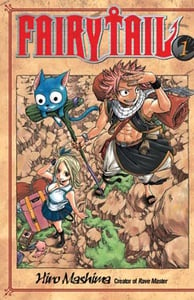Review
by Carl Kimlinger,Fairy Tail
GN 1
| Synopsis: |  |
||
Cute, competent, but not overly-talented magician Lucy wants to join a magician's guild. Not just any guild, but the guild renowned for being home to the wildest, most talented magicians in the land: Fairy Tail. When her fanatical desire to join lands her in the hands of petty slave traders, she's saved Natsu, a young fellow who she had earlier dismissed as a mere oddball. Gluttonous, motion-sickness prone, and accompanied by a sidekick who resembles the misbegotten offspring of an alley cat and a bobblehead, Natsu isn't exactly a knight in shining armor, but he is powerful (if amazingly reckless) and he may be Lucy's ticket into the guild of her dreams. Only, as it turns out, the dream is more hazy-night-after-a-batch-of-bad-tacos than happily-ever-after. |
|||
| Review: | |||
Here's a movie idea for you: a manga artist/globe-trotting adventurer breaks into a secret underground city below Mt. Fuji to recover an ancient book containing every character type and plot formula known to manga in order to prevent it from falling into the hands of an evil manga artist intent on reducing the brains of an entire generation to lime-flavored jello. And the best part about the movie is that you could use Fairy Tail as the evil artist's masterpiece without changing a thing. Okay, so perhaps reading Fairy Tail won't end with Bill Cosby making wiggly green desserts out of your grey matter, but it definitely could have been written using that book. Natsu, with his strong principles, insane power, and single wacky weakness is straight out of some shounen action how-to manual, as are the intrusive world-building info-dumps, progression from powderpuff to slowly more menacing villains, and Natsu's craaaazy bevy of magician buddies. Every story follows the same “Natsu seems in dire straits until he pulls out the stops and proves just how butt-kicking he really is” pattern, and the mix of goofy humor, face-crushing action and teary-eyed sap is so calculated as to be mechanical. Of course there's no law saying that something utterly devoid of imagination can't be fun, and Fairy Tail does have its moments, usually involving the goofy humor. The Fairy Tail guild guys' “amusing” bickering quickly grows irritating, and as often as not the jokes are merely stupid, but occasionally the manga delivers some solid laughs, such as the deadpan happy-family montage starring a young Natsu and a giant dragon, or Lucy's awful relationship with the various dorky, usually useless, celestial spirits that she summons. As for the all-important action, the manga is still at that stage where Natsu is battling enemies obviously far below his own level. The fights are trading in coolness rather than tension for now, and Hiro Mashima—a self-proclaimed punk—certainly has an eye for cool poses and slow-motion fight choreography. The choreography in particular bodes well for when (or if) the manga ever gets around to building fights that actually matter. His art in general is detailed, filled with carefully-constructed settings, hunky guys and cute girls, but suffers from one overriding defect: It isn't really his. To say that Mashima was influenced by Eiichiro Oda's work on One Piece is to grossly underestimate the slavish skill with which Mashima apes Oda's distinctive style. Everything—from the dark-hatched facial expressions, to the lanky, sexy female designs, to the cluttered barrooms plastered with wanted posters, to the simple eyes, six-packs, stylin' clothes, and grotesquely comic faces of the supporting characters—could practically have been drawn by Oda himself. Even the crowded panels and wacked-out angles would be right at home in One Piece. Mashima's characters have a stronger “bite me” vibe (punk influences?) and he revels rather less in sheer weirdness, but the similarity is still so strong that it's damned difficult to appreciate his undeniable technical skill. As always Del Rey presents a solid book, with clear art and useful translator's notes. Extras are scant—some explanations by Mashima about various aspects of his world—and there's no next-volume preview, but few will miss them. Sometimes the dialogue makes no sense whatsoever, but it's hard to tell if fault lies with the translation or with Mashima's random writing. In the world of shounen action, the devil's in the details. It can't be in the plot, tone or philosophy, since those always stay the same. Instead, shounen series attempt to distinguish themselves with character quirks, new systems of fighting, and the details of the world their authors create. As such, the formulaic structure and hackneyed plot of Fairy Tail are merely to be expected. What disappoints is that it borrowed so many of the important details—character relationships and personalities, punky mix of archaic and modern technologies, the very look of the series—from pre-existing sources. Unless it manages to miraculously deepen its characterizations or summon some virtuoso suspense, this series is doomed to be nothing more than a mild, forgettable diversion. |
| Grade: | |||
|
Overall : C
Story : C-
Art : C+
+ Occasionally amusing, mildly cool shounen adventure. |
|||
| discuss this in the forum (10 posts) | | |||
| Production Info: | ||
|
Full encyclopedia details about Release information about |
||